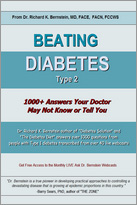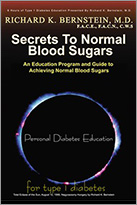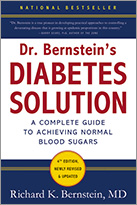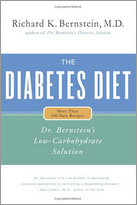Comments by Dr. Rickard K. Bernstein
January 2008
Dr. Bernstein has commented on some of the changes in the 2008 clinical guidelines issued by the American Diabetes Association.
I have before me the American Diabetes Association Clinical Practice Recommendations for 2008. Copies are available online from the American Diabetes Association. I will provide page numbers for the topics to which I am referring.
In my opinion, the American Diabetes Association is slowly moving in the right direction with the diagnosis of diabetes. They diagnose pre-diabetes in a similar way as they did in 2007, with guidelines suggesting a fasting blood sugar over 100 mg/dL, actually between 100 and 125mg/dL. They diagnose early impaired glucose tolerance with a result of a two-hour oral glucose tolerance test greater than 140 mg/dL. A greater than 200 mg/dL on an oral glucose tolerance test or random plasma glucose greater than 200 mg/dL is required for the diagnosis of diabetes. In 2007, the random plasma glucose of greater than 200 mg/dL was required on two different occasions. The 2008 guidelines have tightened control by stating only one occasion is needed for diagnosis. Refer to page S13.
Let’s turn now to page S18 of the recommendations, where blood sugar goals for adults with diabetes are discussed. They recommend 70-130 mg/dL before meals and less than 180 mg/dL after meals. I would like to point out that they recommend higher blood sugars in children. My personal blood sugar goal for patients without severe gastroparesis is around 83 mg/dL before, during, or after meals.
The guidelines recommend a hemoglobin A1c of less than 7%, which is an average blood sugar of 170 mg/dL. The guidelines do acknowledge “more stringent glycemic goals, less than 6%, may further reduce complications at the cost of increased risk of hypoglycemia.” They recognized the fact that there is value to lower blood sugars. The increased risk of hypoglycemia would only apply to people taking insulin on high carbohydrate diets. Patients with low carbohydrate diets take smaller doses of insulin and would be able to control the effects without hypoglycemia. In my experience, I have seen many doctors tell a patient with an A1c of 5.5% that they need to raise their A1c or they’ll “burn their brain out.” “Less stringent A1C goals may be appropriate for patients with a history of severe hypoglycemia, patients with limited life expectancies, and children.” In my practice, children are treated with same normal blood sugar goals as adults. Refer to S18-19.
Carbohydrate Intake in Diabetes Management is on page S20. “Monitoring carbohydrate intake, whether by carbohydrate counting, exchanges or experience-based estimate remains the key strategy in achieving glycemic control.” The ADA recognizes that the major factor in blood sugar determination is carbohydrate. On page S21, “the recommended dietary allowance for digestible carbohydrate is 130 grams per day and is based on providing adequate glucose as the required fuel for the central nervous system.” “For individuals who have diabetes, the use of the glycemic index and glycemic load may provide a modest additional benefit for glycemic control over that observed when total carbohydrate is considered alone.”
Once concern I have is with the guidelines focusing mainly on carbohydrates. Protein doesn’t raise sugar anywhere near as much as carbohydrate; however it can still raise blood sugar. Protein raises blood sugar by two mechanisms. The first mechanism is gluconeogenesis, which is the conversion of a small percentage of the protein to glucose. It converts to about 2 grams of glucose per ounce of protein, a very small percentage. An ounce is 28.5 grams. If you eat a 12-ounce steak, those grams can add up. The other mechanism by which protein raises blood sugar is the incretin effect, which in my books, I call the “Chinese Restaurant Effect.” Just distending your gut with anything will raise blood sugar, even a handful of pebbles, if you are a severe diabetic like me. So, just the presence of that steak in your gut will distend the gut, causing you to release hormones that will raise blood sugar. The first paper that I ever wrote that got published was published in the mid-1970s, somewhere around 1975, in a remote publication called Acta Paediatrica Belgique. It was entitled, “Protein as the Principal Source of Glucose in the Treatment of Diabetes.” If you eat protein as your major source of calories, you can derive glucose from the excess over what protein you need to build your muscles. Any excess protein gets slowly converted to glucose. You’re trickling in glucose slowly at a pace that can be covered with insulin.
On page S20, it states “the use of sugar alcohols appears to be safe.” However, they may cause diarrhea, especially in children. Sugar alcohols like sorbitol do raise blood sugars about two-thirds as much as pure table sugar. If you are going to use a lot of sorbitol, it is going to raise your blood sugar considerably.
Page S33 relates to foot care. “Callous can be debrided with a scalpel by a foot care specialist or other health professional with experience and training in foot care.” I, for many years, have been director of the wound care clinic at a major medical school. Whenever a diabetic patient would come in, they would be sent to me. When I had a patient who had a prior amputation who had come in for me to take care of the other foot, I’d ask the patient what caused the amputation. In 100% of the cases, it was an attempt to remove a callous on the bottom of the foot or on the side of a toe. The callous was usually removed by a podiatrist, but also sometimes by the patients themselves or a family member. Making a mistake and going a little too deep is enough for an ulcer that doesn’t heal and spreads an infection up the fascial planes of the foot and leg that leads to an amputation. By way of example, I was once treating a chiropractor. It was a Friday, and he, unbeknownst to me, went to a podiatrist. On Monday morning, I get a call from the podiatrist, “What antibiotic do you want me to give this guy?” I said, “What are you talking about?” He says, “Well, he may have a slight infection in his foot.” I said, “Send him in to me. I want to see him.” I removed 5 cc’s of puss from his big toe . This occurred between Friday afternoon and Monday morning. That’s how fast it can happen. Callous debridement is one of the most dangerous things you can do to a diabetic.
Page S63 states “gastric reduction surgery can be an effective weight loss treatment for obesity and may be considered in people with diabetes who have BMI greater than 35kg/m2. The newly available hormones, Byetta and Symlin, which have remarkable and dramatic effects upon overeating are not mentioned in the guidelines, but may be beneficial in these patients.
Let’s look on page S64 which talks about Nutrition Recommendations for the Management of Diabetes. “Recommendations – A dietary pattern that includes carbohydrate from fruits, vegetables, whole grains, legumes, low fat milk is encouraged for good health.” Another recommendation is “sucrose-containing foods can be substituted for other carbohydrates in the meal, in the meal plan or if added to the meal plan covered with insulin or other glucose lowering medications.” It is difficult for insulin to work fast enough to cover table sugar. Also, unless you’re weighing the sucrose you are going to consume, there’s not way of knowing how much you’re getting in terms of grams.
The next page, page S65, “The RDA for carbohydrate, 130 grams a day is an average minimum requirement.” I believe the recommendation for carbohydrates should be lower. Until the development of agriculture and the creation of flour and bread, our ancestors couldn’t get anywhere near 130 grams of carbohydrate a day. Our prehistoric ancestors did not have atherosclerosis. We have their remains, with no sign of arterial disease. They were not obese and as far as we can determine, there was no diabetes. Now, that we’re eating much more carbohydrate, you could look back over the 20th century and see what has happened to the health of humans as the amount of carbohydrate ingested has increased. The prevalence of chronic disease like diabetes, heart disease, and obesity has skyrocketed with these high carbohydrate intakes.
In the next paragraph the guidelines state “the amount of carbohydrate ingested is usually the primary determinant of post-prandial response but the type of carbohydrate also affects this response.” They state that carbohydrate is what makes blood sugars high and also that if you use the sweet carbohydrate, like sugar and bread, you’re going to have even more of an effect on blood sugar.
On the next page, S66, the protein guidelines have not changed from previous versions. “There’s insufficient evidence to suggest that usual protein intake, 15% to 20% of energy should be modified. High protein diets are not recommended as a method for weight loss at this time. The long-term effects of protein intake, greater than 20% of calories on diabetes management and its complications, are unknown. Although such diets may produce short-term weight loss and improved glycemia, it has not been established that these benefits are maintained long-term and long-term effects on kidney function for patients with diabetes are unknown.” I have treated many patients with protein in the urine, including myself. I had 4-plus proteinuria, and when I went on a low carbohydrate/high protein diet, I totally eliminated the proteinuria. I think the last time we checked it, it was immeasurable even though normal is up to 150 mg a day. If you catch diabetic kidney disease early enough, and if you normalize blood sugars, you can eliminate the proteinuria and the kidney damage. I have a few cups of salad a day. I have a little bit of carbohydrates in cheese and all the rest of my calories are from protein and fat. My serum creatinine after 62 years of diabetes is 0.96. My kidneys, as well as those of numerous other patients over the past 25 years, have recovered.
Next, “To reduce risk of nocturnal hypoglycemia, an individual using insulin or insulin-secretagogues, alcohol should be consumed with food.” My recommendation to patients who consume alcohol is the safest time to consume alcohol is not near food. Why? I learned it the hard way. In fact, long before I became a physician, but after I got my first three-pound blood sugar meter, I was the guy who was the Wall Street contact for my employer. I had taken them public and securities analysts used to take me out for those “two-drink lunches.” I barely survived the first two. At the first one, I felt very sick. I said, “I think I had too much to drink.” Fortunately, I had a friend join us from my company, and he said, “Hey, Dick, you look like death. I bet your blood sugar is near zero.” Well, I had my big meter with me, took it out, and I was under 30 mg/dL. Why would my blood sugar be under 30 if I had a full meal? I had covered it with the right amount of insulin. Alcohol can paralyze the liver if you have too much. The liver is the major agent that converts protein to glucose. So here, I was covering so many ounces of protein at lunch with insulin. The insulin was working but the protein was not turning to glucose because I had too much alcohol.
The ADA guidelines do not include a recommendation that insulin users check their blood sugars before driving, and every hour if on a long trip. A major article was in the Journal of Diabetes Care almost a year ago. It pointed out that there are considerable numbers of automobile accidents caused by diabetics who are having hypoglycemia.
Page S69 includes “Recommendations – reduction of protein intake to eight-tenth to 1 gram per kilogram of body weight.” This is a minimum for people who don’t want to suffer from protein malnutrition. On page S70, they say, “Normal protein intake, 15% to 20% of energy does not appear to be associated with risk of developing diabetic nephropathy. But the long-term effect on the development of nephropathy of dietary protein intake greater than 20% has not been determined.” I try to ensure that my patients take at least that amount. If the patient is exercising and trying to build muscle mass, they may need considerably more protein.
On page S98, they discuss diabetes self-management education. They say you should have several instructors and at least one of the instructors will be a registered nurse, dietician or pharmacist. I would like to see doctors being permitted to educate patients.




